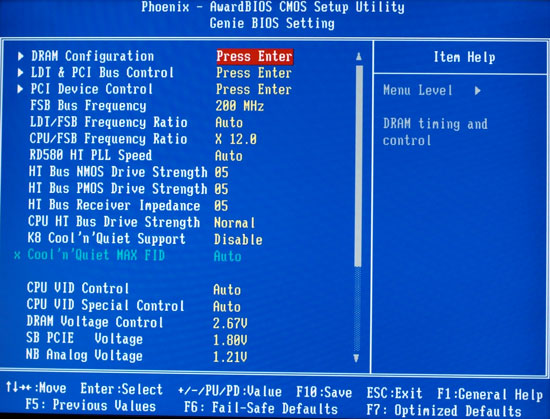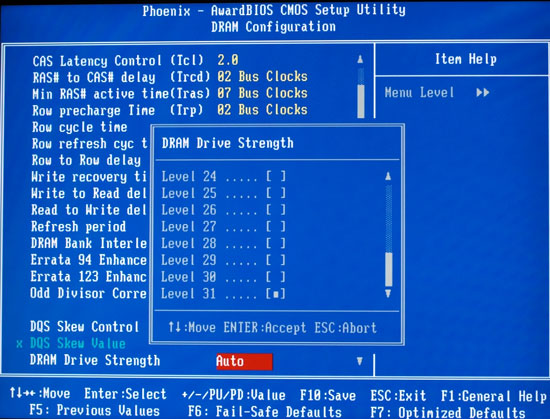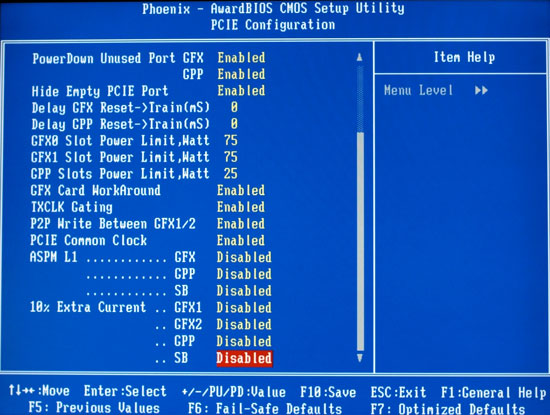DFI CFX3200-DR: ATI RD580 Tweak Attack
by Wesley Fink on May 8, 2006 12:05 AM EST- Posted in
- Motherboards
Basic Features
| DFI CFX3200-DR Features | |
| CPU Interface | Socket 939 Athlon64 |
| Chipset | ATI RD580 Northbridge - ULi M1575 Southbridge |
| Bus Speeds | 0 to 500 in 1MHz Increments |
| Memory Speeds | DDR200,240,266,280,300,333,360,400 (433,466,500 with Rev. E AMD) |
| PCIe Speeds | 100 to 150 in 1MHz Increments |
| PCI/AGP | Fixed at 33/66 |
| Core Voltage | Auto, 0.8V to 1.55V in 0.025V increments PLUS VOLTAGE x 101.4%, 102.9%, 104.3%, 105.8%, 107.2%, 108.6%, 110.0%, 111.5%, 113.0%, 114.4%, 115.8%, 117.3%, 118.7%, 120.2%, 121.6% (Maximum vCore 1.88V) |
| CPU Clock Multiplier | 4x-25.0x in 0.5X increments |
| DRAM Voltage | 2.06v to 4.15v in .01v to .03v increments |
| HyperTransport Frequency | 1000MHz (1GHz) (Stable in overclocking to 1500+ HT) |
| HyperTransport Multiplier | Auto, 1X to 5X |
| Northbridge Over-Voltage: | Auto, Disabled, Enabled Enabled adds 3 additional voltage options below |
| NB Core Voltage | 1.21v, 1.34v, 1.47v, 1.60v |
| NB Analog Voltage | 1.21v, 1.34v, 1.47v, 1.60v |
| HyperTransport Bus Voltage | 1.21v, 1.34v, 1.47v, 1.60v |
| SB PCI Express Voltage | 1.8v, 1.85v, 1.9v, 1.95v |
| GFX1/2 (PCIe) Link Width | X16,x12,x8,x4,x2,x1 |
| GFX and/or SB Payload | 64,32, or 16 Bytes |
| Delay GFX Reset | 0 to 200mS in 1mS increments |
| Delay GPP Reset | 0 to 200mS in 1mS increments |
| GFX 1 and/or 2 Slot Power Limit | 0 to 250 watts in 1 watt increments |
| GPP Slot Power Limit | 0 to 250 watts in 1 watt increments |
| +10% Extra Current | GFX1,GFX2,GPP, and/or SB |
| RD580 HT PLL Speed | Auto, High Speed, Low Speed |
| HT Bus NMOS Drive Strength | 00-31 in 1 increments (32 Settings) |
| HT Bus PMOS Drive Strength | 00-31 in 1 increments (32 Settings) |
| HT Bus Receiver Drive Strength | 00-31 in 1 increments (32 Settings) |
| AMD Cool'n'Quiet | Auto, Disable |
| Cool'n'Quiet Max FID | Auto, 8.0x to 13x in 0.5x increments |
| Memory Slots | Four 184-pin DDR DIMM Slots Dual-Channel Configuration Regular Unbuffered or ECC Memory to 4GB Total |
| Built-In Memory Test | Disabled, Enabled |
| DQS Skew Control | Increase (+) or Decrease (-) -255 to 255 in 1 increments |
| Expansion Slots | 2 PCIe X16 2 PCIe X1 3 PCI Slots |
| Onboard SATA/RAID | 4 SATA2 Drives by ULi M1575 (RAID 0,1,1+0,5,JBOD) 4 SATA Drives by Silicon Image 3114 (RAID 0,1,0+1,JBOD) |
| Onboard IDE/IDE RAID | Two Standard ATA133/100/66 (4 drives) |
| Onboard USB 2.0/IEEE-1394 | 8 USB 2.0 ports supported by ULi M1575 2 Firewire by VIA VT6307 |
| Onboard LAN | PCIe Gigabit by Marvel Yukon 88E8052 PCIe Gigabit by Marvel Yukon 88E8053 |
| Onboard Audio | Azalia HD Karajan Audio Module powered by Realtek ALC882 codec |
| BIOS Revision | Award 417 (4/17/06) |
There is a very good reason that the Basic Features chart is the largest we have ever created for a review. DFI has a reputation for providing a huge array of adjustments on their enthusiast-oriented motherboards, and it normally is a challenge to describe the range of adjustments available on DFI motherboards. The CFX3200-DR takes that to a new level, however, with the widest and finest adjustments ever seen on a production motherboard. Despite the size of the expanded features table, we still couldn't include everything you can adjust on this DFI. This will be welcomed news to those that want to test and control every aspect of their computing experience.

DFI uses the familiar Award BIOS to control the DFX3200. Most adjustments of interest to overclockers and enthusiasts will be found under the "Genie BIOS Setting" sub-menu. Adjustments are so extensive they require 2 pages for base options.


Additional submenus under the Genie Settings include a full range of DRAM controls, with every setting for menu you could imagine - and a few more you probably didn't even know existed. These include skew control with 511 adjustment levels (+/- 255 steps).

DRAM drive strength includes 31 discrete levels of drive strength. No one will ever complain about lack of control on the DFI CFX3200. We are fans of extensive adjustment options in the BIOS, but the DFI may take things too far for some enthusiasts. There need to be more auto settings that work for the great majority of users. Users can then go deeper if they choose, with confidence the "auto" settings will get them going.
Since the CFX3200 was first received there have been several BIOS revisions. The shipping BIOS had issues with many memory types and would not even boot with some memories. The BIOS used in this review, the 417, worked well with almost any memory we had for testing, but it took several revisions to get there. As with past DFI boards you will likely find a huge number of custom BIOS revisions floating around that have been developed to work best with one hot memory or another. This allows you to squeeze the last bit of performance out of any memory with the DFI, but it can sometimes be a daunting challenge if you are running a memory that is not the hottest DRAM of the week.


"Advanced Features", "PCIe Configuration" is another submenu loaded with tweaks to squeeze a bit more from the board. These include the ability to set the link width of the two X16 ports, custom control of slot resets, and fully adjustable slot wattage from 0 to 250 watts. You can also set peer to peer writes between graphics slots which is reported to be a requirement for running SLI on an ATI chipset board, and boost current to slots and the Southbridge. Many are reporting that adjustments in this sub-menu can allow a bit more performance from your graphics system.
We have just scratched the surface on the extensive CFX3200-DR BIOS. There are already guides appearing on several forums and we would suggest that you look more deeply at one of these tweak guides if you want to know more about setting up this DFI board for best performance with a particular memory or graphics card setup.










25 Comments
View All Comments
Stele - Wednesday, May 10, 2006 - link
IMHO the main disadvantage of using the Sil3114 instead of a newer SATA controller like the 3132 is not so much the 1.5Gbps transfer rate, but the fact that it's PCI-based and hence badly bottlenecked once you fill all four channels. 1.5Gbps is a theoretical maximum and HDDs today are nowhere near that limit - in fact we left ATA-133 without even breaking the ATA-100 limit. Since each SATA HDD gets a dedicated 1.5Gbps channel, arrays won't saturate the SATA interface either - rather, they would saturate the slow PCI interface as previously mentioned. Furthermore, the other significant feature of SATA II - NCQ - is of virtually zero relevance to most users, unless one is using the board in a corporate server; not impossible, but not likely either. Therefore, to harp on a figure that has generally been more a marketing tool (as was ATA-133) than a real necessity says little of the real issues at hand.In return, using the Sil3114 means using a tried and tested product whose characteristics are very well known by now. Board engineers would know how best to design around it - what special requirements (signal integrity, trace lengths, coupling etc), if any, need to be factored in, how the controller performs and behaves and so on. Furthermore, the 3114 provides 4 SATA ports for maximum expansion capability - there is no 4-port version of the 3132 as you alluded to in the review - not yet anyway. You may well be right about having a truckload of 3114s to get rid off, so that's likely a factor too. Perhaps when the 3132 gains a 4-port counterpart (and DFI finishes off 3114 inventory) then we may see newer stuff to come. :)
On another side note, yes there would probably be many people who would appreciate the insane options in BIOS, but I do agree that they should make the UI more user-friendly, e.g. by having Automatic as a choice and/or by placing advanced options in sub-menus to distinguish them from the main options. That would satisfy enthusiasts of all levels, from the mad hatters down to the ones who are just starting out. :)
Generally a review well done! :)
Stele - Wednesday, May 10, 2006 - link
Perhaps that statement should be clarified/qualified a little - there is no 4-port version of the 3132 (i.e. PCIe + SATA II + 3.0Gbps) in a single controller IC. The 3132 supports, and hence is expected to be used with, SATA port multipliers - primarily the SII 3726, which can support up to 5 drives. In future, DFI could use a 3132 with one SATA channel routed to an external connector (as in the Asus A8N32-SLI) while the other channel could be connected to a 3726 to provide an additional 4 or even 5 internal HDD channels.
However, this would create two problems - the need for another IC (the board is already very cramped as it is!) and, as already discussed, the need to gain sufficient experience with the new ICs in the lab before they can be confidently implemented and designed around. Cost and time-to-market factors may also have played a role in DFI's choice.
proamerica - Monday, May 8, 2006 - link
This is a poor quality review. The reviewer complains too much about variables that actually improve performance when handled by the right person. The overclocking potential of this board is beyond all other 939 boards I have owned, including the A8R32-MVP... People all over the place are reporting the highest overclocks ever achieved for memory and CPUs. You have to know what you are doing I'm afraid, and yes it requires using all the settings in the BIOS. That is the caveat of buying this board, its hard to use, and it takes time to figure it out, but once you do its worth it. I stably OC'ed my X2 3800 to 2940Mhz, and I currently run it 24/7 at 2700Mhz. Is 2940Mhz the highest OC I have ever gotten with this processor? Yes, stably, by far the highest. One of the greatest aspects of this board is that it will overclock really high but it doesn't take a lot of voltage to get things stable.Why does the review say: "but this DFI does make us wonder how many end users will actually devote the time to master 32 levels of drive strength, and DQS skew levels of +/- 0 to 255 in 511 levels." Lets see, an extremely expensive motherboard from a company known for making the most tweakable boards around... And you wonder if end-users are going to bother? Yeah they're going to bother. If they don't, they should have purchased something else.
Bottom line, this board beats the A8R32-MVP hands down, its just harder to use than the Asus.
Wesley Fink - Tuesday, May 9, 2006 - link
The review pointed out what you clearly found. It's a difficult board to master, but the options and performance can be outstanding. Some want to take the time to master it, others would prefer a board that is easier to overclock. The real poiunt is the DFI CFX3200 still needs work. The BIOS does NOT need to be so difficult to master, and it wouldn't be if more intelligent choices were made for auto settings.The CFX3200 is not a bad board, it is just a very difficult board to use and master - even for an experienced enthusiast.
Zoomer - Wednesday, May 10, 2006 - link
As mentioned by someone else, the auto (default) settings are nicely choosen - for BH5 memory.Perhaps it would be wise to point that out somewhere, or provide an option of memory: BH5/Normal/Valueram/Manual
ozzimark - Monday, May 8, 2006 - link
"Running four double-sided 512MB or 1GB DIMMs is much more demanding than running two DS DIMMs, and like almost every board we have tested the Command Rate needed to drop to 2T with 4 DS DIMMs."using a high dram drive strength should allow for stable opteration at 1T with 4 double rank sticks in.. :)
bigtoe36 - Monday, May 8, 2006 - link
From the Tweak guide on the bleedinedge forum."Max async latency - options 7 thru 10 are all you should need, 7 for agressive tight timings 10 for high fsb overclocks. This option HAS TO BE SET MANUALLY
Read Preamble - 4.5 thru 6 is all you need worry about, 4.5 for BH5 etc and 6 for high fsb overclocks. i usually use 5.5 and 6. Again HAS TO BE SET MANUALLY"
http://www.bleedinedge.com/forum/showthread.php?t=...">http://www.bleedinedge.com/forum/showthread.php?t=... for the full guide.
Wesley you have the options posted on page 4 the wrong way round, its easy to do as I often get them confused.
Tony
ozzimark - Monday, May 8, 2006 - link
with dfi boards, it's long been my experience that manually setting MAL/RP is a VERY BAD thing.bigtoe36 - Monday, May 8, 2006 - link
Normally that would be the case but DFI were setting 4.5 and 5 as hidden defaults. Now if you are running Bh5 you will have no problems, but most everything else would have issues.Thats why i quoted in my guide and on MANY forums you have to set these manually to get the best from the board.
mbhame - Monday, May 8, 2006 - link
Where's the USB/Firewire CPU Utilization and I/O? Where's IDE performance?Throughput is not indicative of real-world performance for any user I know.